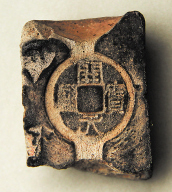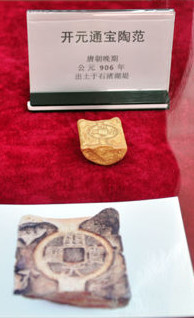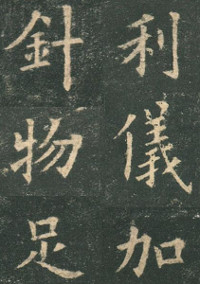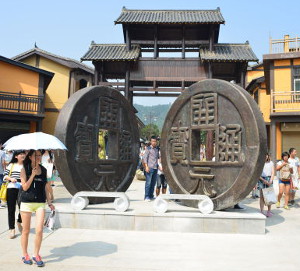The world’s only known specimen of a Tang Dynasty clay mould used to cast kai yuan tong bao (开元通宝) coins is now on public display according to Chinese news reports dated January 6, 2015.
This very rare clay mould (钱陶范), which is classified as a “national treasure” (国宝级), was unearthed in Shutang on August 17, 1992 by Mr. Ceng Jingyi (曾敬仪), a retired teacher and coin collector.
Shutang is located in the Wangcheng District (望城区) which is about 20 km from Changsha (长沙) in Hunan Province (湖南).
The clay mould is on display at the “Exhibition of Chinese Ancient Coins” (中国历代钱币展) being held at the Ouyang Xun Cultural Park (欧阳询文化园) located in Shutang (书堂).
Kai yuan tong bao coins were cast beginning in the year 621 during the reign of Emperor Gaozu (高祖) of the Tang Dynasty (618-907).
The kai yuan tong bao, which translates as the “Inaugural Currency”, marked a watershed in Chinese history.
Up until this time, Chinese coins had been named after their weight. Beginning with the casting of the kai yuan tong bao, coins were now designated as tong bao (“circulating currency” 通宝) or zhong bao (“heavy currency” 重宝).
This new coin replaced the wu zhu (五铢) coins which had been produced for more than 700 years.
Ouyang Xun (557-641) was born in Shutang and is recognized as one of the most famous calligraphers of the Tang Dynasty.
Ouyang Xun was selected by Emperor Gaozu to write the inscription for the kai yuan tong bao coin.
The inscription is written in a combination of Han Dynasty lishu (“Clerical” 隶书) and bafen (八分) scripts.
This was also the first time in history that a famous calligrapher wrote the characters for a Chinese coin.
Ouyang Xun is considered the finest calligrapher of the Tang of a style known as “regular script” (kai shu 楷书), also referred to as “standard script”.
His calligraphy was immortalized on a stone stele located at Emperor Taizong‘s palace on Tiantai Mountain (天台山).
The work is known as the “Jiucheng Palace Sweet Wine Spring Inscription” (九成宫醴泉铭) and is considered the model for “regular script” even today.
In addition to the rare clay mould, the exhibition also includes more that 1,000 ancient Chinese coins donated by Mr. Ceng.
The opening of the Chinese coin exhibition featuring the clay mould also received television coverage. Please click here to view one of the television broadcasts covering the event.
In the 2-minute video, Mr. Ceng Jingyi is interviewed (0:49 mark) and the kai yuan tong bao clay mould is shown (1:28 mark).
Up until the unearthing of this clay mould, no moulds were known to exist for the casting of the Tang Dynasty kai yuan tong bao coins.
For this reason, it was unclear as to what process was actually used to cast these coins. While the coins could have been cast in the traditional manner from moulds made of clay, stone or bronze, it was believed that the coins were now being cast in sand using “mother” coins to make the impressions.
With the discovery of this clay mould, however, it is now confirmed that clay moulds were still being used to cast coins during the Tang Dynasty.



